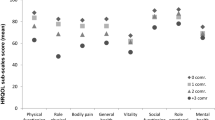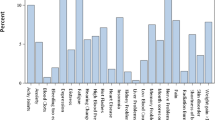Abstract
Purpose
Each year, nearly 21,000 adolescents and young adults (AYA) ages 15 to 29 years are diagnosed with cancer. Breast and gynecological cancers account for 25 % of the cancers seen in AYA females. The purpose of this study was to compare the current physical and mental health status of female AYA cancer survivors with non-cancer female controls.
Methods
Using data from the population-based 2009 National Health Interview Survey, 100 cases of female AYA survivors of breast and gynecological cancers were identified [female AYA cancer survivor (FCS) group]. FCS cases were matched with 300 female respondents without a history of cancer on age, education, marital status, and minority status [non-cancer control (NCC) group]. The FCS and NCC groups were compared on a range of physical and mental health status indices using analysis of covariance and binary logistic regression.
Results
FCS group reported significantly poorer physical and mental health status than the matched controls. Relative to the NCC group, FCS survivors had significantly poorer scores on 7 of 8 mental health outcomes and were more likely to meet criteria for serious psychological distress (odds ratio = 4.23, p ≤ 0.001). FCS group also reported greater lifetime and current prevalence of various medical conditions, more health-related disabilities, and greater functional limitations than the NCC group.
Conclusion
Diagnosis of breast and gynecological cancer during adolescence and young adulthood is associated with clinically important deficits in physical and mental health status. Given the young age of this cancer survivor cohort, increased attention should be devoted to minimizing these deficits.
Similar content being viewed by others
References
Bleyer A, Viny A, Barr R (2006) Cancer in 15- to 29-year-olds by primary site. Oncologist 11:590–601. doi:10.1634/theoncologist.11-6-590
National Cancer Institute & LIVESTRONG Young Adult Alliance (2006) Closing the gap: research and care imperatives for adolescents and young adults with cancer. National Institutes of Health Publication No. 06-6067
Abrams AN, Hazen EP, Penson RT (2007) Psychosocial issues in adolescents with cancer. Cancer Treat Rev 33:622–630. doi:10.1016/j.ctrv.2006.12.006
Evan EE, Zeltzer LK (2006) Psychosocial dimensions of cancer in adolescents and young adults. Cancer 107:1663–1671. doi:10.1002/cncr.22107
Hedstrom M, Ljungman G, von Essen L (2005) Perceptions of distress among adolescents recently diagnosed with cancer. J Pediatr Hematol Oncol 27:15–22
Mattsson E, Ringner A, Ljungman G et al (2007) Positive and negative consequences with regard to cancer during adolescence. Experiences two years after diagnosis. Psycho-Oncology 16:1003–1009. doi:10.1002/pon.1162
Canada AL, Schover LR (2012) The psychosocial impact of interrupted childbearing in long-term female cancer survivors. Psycho-Oncology 21:134–143. doi:10.1002/pon.1875
Gorman JR, Malcarne VL, Roesch SC et al (2010) Depressive symptoms among young breast cancer survivors: the importance of reproductive concerns. Breast Cancer Res Treat 123:477–485. doi:10.1007/s10549-010-0768-4
Ruddy KJ, Gelber S, Ginsburg ES et al (2011) Menopausal symptoms and fertility concerns in premenopausal breast cancer survivors: a comparison to age- and gravidity-matched controls. Menopause 18:105–108. doi:10.1097/gme.0b013e3181ef39f8
Abbott-Anderson K, Kwekkeboom KL (2012) A systematic review of sexual concerns reported by gynecological cancer survivors. Gynecol Oncol 124:477–489. doi:10.1016/j.ygyno.2011.11.030
Goncalves V (2010) Long-term quality of life in gynecological cancer survivors. Curr Opin Obstet Gynecol 22:30–35. doi:10.1097/GCO.0b013e328332e626
Grover S, Hill-Kayser CE, Vachani C et al (2012) Patient reported late effects of gynecological cancer treatment. Gynecol Oncol 124:399–403. doi:10.1016/j.ygyno.2011.11.034
Howard-Anderson J, Ganz PA, Bower JE et al (2012) Quality of life, fertility concerns, and behavioral health outcomes in younger breast cancer survivors: a systematic review. J Natl Cancer Inst 104:386–405. doi:10.1093/jnci/djr541
Ashing-Giwa KT, Lim JW (2009) Examining the impact of socioeconomic status and socioecologic stress on physical and mental health quality of life among breast cancer survivors. Oncol Nurs Forum 36:79–88. doi:10.1188/09.ONF.79-88
Saquib N, Pierce JP, Saquib J et al (2011) Poor physical health predicts time to additional breast cancer events and mortality in breast cancer survivors. Psycho-Oncology 20:252–259. doi:10.1002/pon.1742
Institute of Medicine (2006) From cancer patient to cancer survivor: lost in transition. National Academy Press, Washington, DC
National Center for Health Statistics (2010) 2009 National Health Interview Survey (NHIS) public use data release. NIH Survey description. Available at: www.cds.gov/nchs/nhis accessed on August 1, 2011
Kessler RC, Barker PR, Colpe LJ et al (2003) Screening for serious mental illness in the general population. Arch Gen Psychiatr 60:184–189. doi:10.1001/archpsyc.60.2.184
Kessler RC, Green JG, Gruber MJ et al (2010) Screening for serious mental illness in the general population with the K6 screening scale: results from the WHO World Mental Health (WMH) survey initiative. Int J Methods Psychiatr 19:4–22. doi:10.1002/mpr.310
Cohen J (1988) Statistical power analysis for the behavioral sciences, 2nd edn. Lawrence Erlbaum Associates, New Jersey
Hays RD, Woolley JM (2000) The concept of clinically meaningful difference in health-related quality-of-life research. How meaningful is it? PharmacoEconomics 18:419–423
Norman GR, Sloan JA, Wyrwich KW (2003) Interpretation of changes in health-related quality of life: the remarkable universality of half a standard deviation. Med Care 41:582–592. doi:10.1097/01.MLR.0000062554.74615.4C
Coups EJ, Ostroff JS (2005) A population-based estimate of the prevalence of behavioral risk factors among adult cancer survivors and noncancer controls. Prev Med 40:702–711. doi:10.1016/j.ypmed.2004.09.011
Hewitt M, Rowland JH (2002) Mental health service use among adult cancer survivors: analyses of the National Health Interview Survey. J Clin Oncol 20:4581–4590. doi:10.1200/JCO.2002.03.077
Abraham L, Geller BM, Yankaskas BC et al (2009) Accuracy of self-reported breast cancer among women undergoing mammography. Breast Cancer Res Treat 118:583–592. doi:10.1007/s10549-009-0375-4
Bergmann MM, Calle EE, Mervis CA et al (1998) Validity of self-reported cancers in a prospective cohort study in comparison with data from state cancer registries. Am J Epidemiol 147:556–562
Acknowledgments
Dr. Celeste Phillips-Salimi is a postdoctoral fellow and received support from T32 Research Training Program in Behavioral Nursing funded by the National Institute of Nursing Research (2T32 NR007066) at Indiana University.
Conflict of interest
The authors have no conflicts of interest to disclose.
Author information
Authors and Affiliations
Corresponding author
Rights and permissions
About this article
Cite this article
Phillips-Salimi, C.R., Andrykowski, M.A. Physical and mental health status of female adolescent/young adult survivors of breast and gynecological cancer: a national, population-based, case-control study. Support Care Cancer 21, 1597–1604 (2013). https://doi.org/10.1007/s00520-012-1701-7
Received:
Accepted:
Published:
Issue Date:
DOI: https://doi.org/10.1007/s00520-012-1701-7




